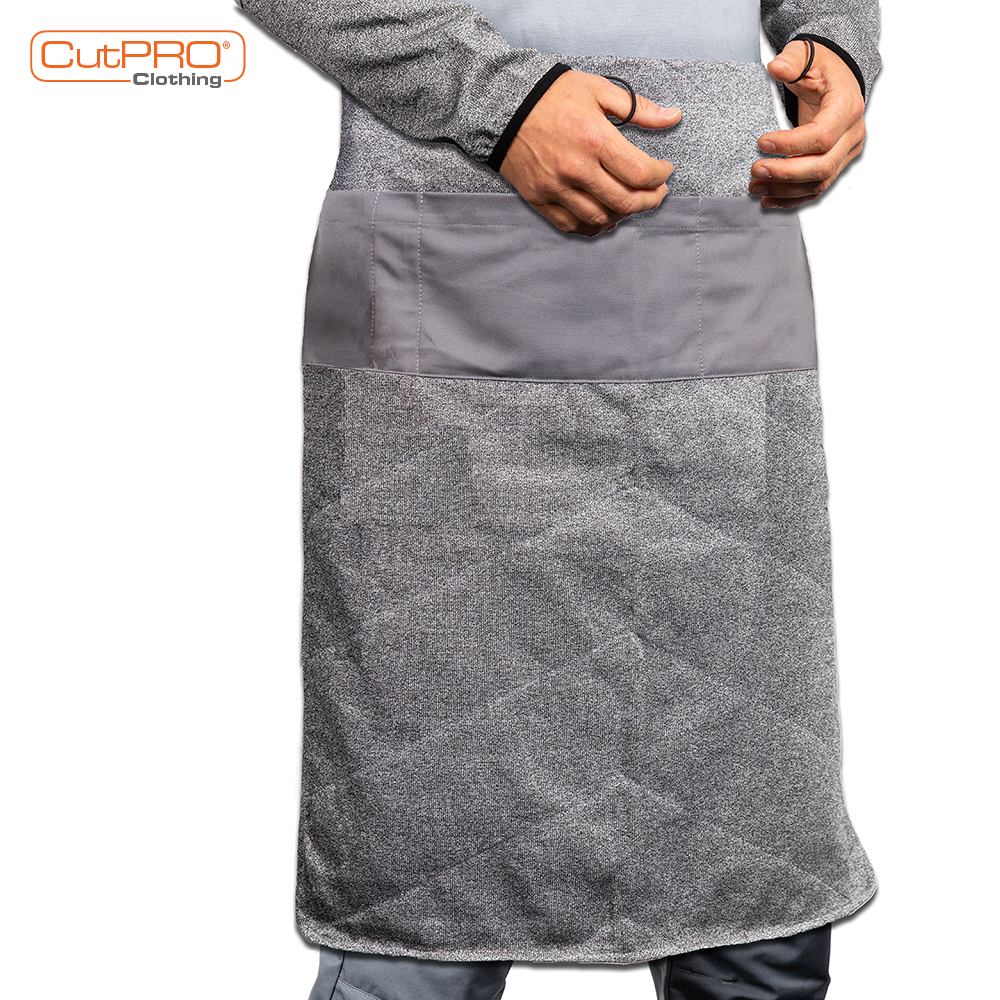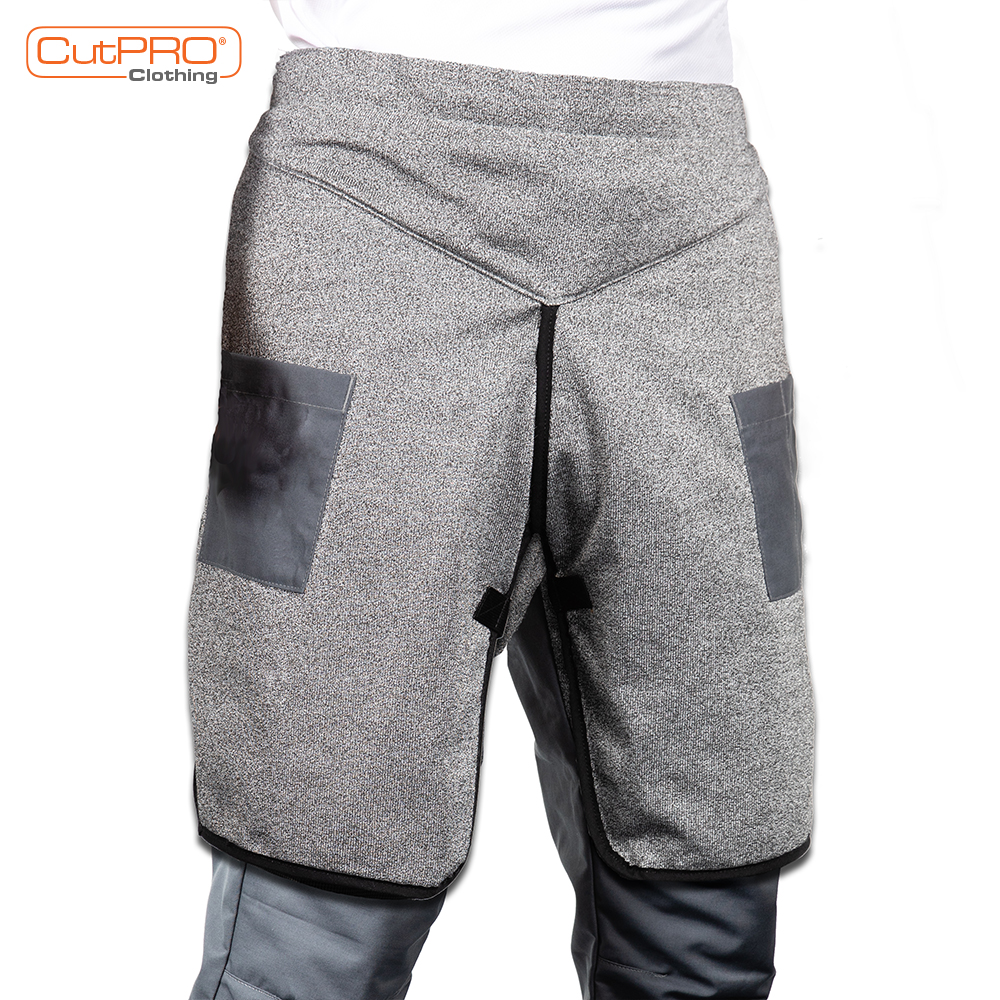When it comes to workplace safety, cut resistant aprons are commonly used in industries such as glass manufacturing, metalworking, and food processing. These aprons provide an additional layer of defence against lacerations, punctures, and abrasions that can occur in environments where sharp tools, glass shards, or metals are handled regularly.
At CutPRO®, we offer a range of cut resistant aprons tailored to meet specific workplace needs. Our selection includes half aprons, split aprons, and full aprons, each designed for different levels of protection and mobility. Whether you need a lightweight half apron for enhanced mobility or a full apron for maximum coverage, our aprons ensure you remain safe without compromising on comfort.
In this article, we will explore the importance of cut resistant aprons, their features, and why they should be an essential part of your PPE arsenal.
What Are Cut Resistant Aprons?
Cut resistant aprons are specially designed garments made from high-performance materials such as Cut-Tex® PRO, Kevlar, or Dyneema. These materials offer advanced protection against slashes and cuts, reducing the risk of injuries in environments where sharp objects or hazardous materials are present. Unlike traditional aprons, which may only protect against stains or dirt, protective aprons provide substantial protection to the wearer’s torso and thighs, where serious injuries often occur.
Key industries where cut resistant aprons are widely used include:
- Glass Manufacturing and Glazing
- Metalworking and Sheet Metal Handling
- Food Processing
- Butchery
- Construction
In these industries, exposure to sharp tools, cutting machinery, or even broken glass can pose significant risks to workers.
The Advantages of Different Apron Styles
Half Aprons
Half aprons provide protection to the waist and thighs, while offering enhanced mobility. These aprons are ideal for workers who need to move around freely or bend frequently, such as those in food processing or light metalworking.
Key benefits:
- Lightweight and less restrictive, allowing greater mobility.
- Suitable for tasks that require dexterity and frequent movement.
- Offers essential protection without hindering movement in fast-paced work environments.
Split Aprons
Split aprons are designed with a split-leg feature, making them perfect for seated or crouching tasks, such as those required in metalworking or butchery. The split design allows for enhanced freedom of movement, particularly for tasks that involve a lot of bending or kneeling.
Key benefits:
- Provides additional leg movement while ensuring robust protection.
- Ideal for jobs that require a flexible seated position or frequent kneeling.
- Combines coverage with mobility, making it suitable for various manual tasks
Full Aprons
Full aprons offer maximum coverage from the chest to the knees, making them the go-to choice for workers in glass manufacturing, where large shards of glass or sharp objects could cause severe injuries.
Key benefits:
- Maximum protection for the torso, abdomen, and thighs.
- Best suited for high-risk environments like construction and glass handling.
- Provides the highest level of cut resistance while covering the most vulnerable areas.
Key Features of Cut Resistant Aprons
Outstanding Cut Resistance
The primary feature of cut resistant aprons is their ability to protect against cuts and lacerations. Materials like Cut-Tex® PRO, which is used in CutPRO® Clothing, are engineered to withstand high levels of force from cutting tools, blades, or sharp materials.
Here are the cut resistance levels for Cut-Tex® PRO:
- ANSI/ISEA 2016: Level A5 Cut Resistance - A high level of cut resistance, ideal for environments with frequent exposure to sharp objects. Understanding ANSI cut levels is critical for selecting the right PPE. ANSI standards provide a precise scale, from A1 (least resistant) to A9 (most resistant), based on the force required to cut through the material. Learn more about ANSI Cut Levels here.
- EN 388:2016 – Level E Cut Resistance (TDM-100 Test) - This European standard measures a material’s ability to resist cuts from sharp-edged objects. The inclusion of the TDM-100 test ensures a more accurate assessment of cut resistant materials. Discover more about EN 388:2016 standards here.
Comfort and Flexibility
While safety is paramount, comfort is also an important factor. Modern safety aprons, such as those made with Cut-Tex® PRO, offer flexibility and breathability, allowing workers to move freely while remaining protected. This is especially useful in physically demanding jobs like metal fabrication, where mobility is essential.
Full Coverage
Unlike cut resistant gloves, which only protect the hands and arms, aprons offer full coverage for the torso and upper legs. This is critical in jobs like glass handling, where large sheets of glass can shatter or metal shards can fall, potentially causing serious injuries if only partial protection is worn.
Durability
In high-risk environments, PPE must be durable enough to withstand harsh conditions. CutPRO® Aprons are designed to endure wear and tear over long periods. They are also resistant to punctures and abrasions, making them more resilient than standard aprons.
Why Protective Aprons Are Essential for Workplace Safety
According to the Health and Safety Executive (HSE), over 15% of non-fatal workplace injuries in the UK were caused by handling, lifting, or carrying. In industries such as metalworking, where sharp objects and hazardous tools are frequently handled, this statistic highlights the need for robust PPE solutions like cut resistant workwear.
In the glass industry, workers are at high risk of injuries from broken glass or sharp shards. A standard fabric apron may offer little to no protection in such cases. However, aprons with cut protection significantly reduce the risk of lacerations, particularly to the abdomen and thighs, which are the most exposed areas during tasks like cutting or lifting large sheets of glass.
Moreover, OSHA reports that the construction industry experiences a high number of injuries due to falls, cuts, and impact from heavy objects. With cut resistant aprons, workers can be better protected from potential accidents while working with sharp tools or around hazardous materials.
The Importance of Protective Aprons in Specific Industries
Glass Industry
Glass handlers often deal with large sheets of material that can shatter unexpectedly. Wearing aprons with cut resistance can prevent potentially life-threatening injuries when glass breaks or sharp shards fly during cutting processes. Cut resistant clothing, including aprons, is a standard safety practice in glass manufacturing and installation.
Metalworking
Working with sheet metal or cutting machinery exposes workers to sharp edges and cutting tools that can cause deep lacerations. A cut protective apron provides additional protection for the torso, preventing injuries from falling shards or direct contact with sharp edges.
Food Processing and Butchery
In the food industry, particularly in meat processing, workers use sharp knives and cutting tools. Cut resistant aprons protect against accidental cuts, making them an essential part of butcher's gear and ensuring that injuries are kept to a minimum during high-speed, repetitive tasks.
Construction
Construction workers often face exposure to sharp materials, from cutting tools to jagged building materials. Cut protective aprons are valuable for ensuring that workers handling such materials remain protected from potential injury.
Choosing the Right Protective Apron
When selecting a protective apron, it's important to consider the specific risks of your industry. Key factors include:
- Cut resistance levels: Ensure the apron meets relevant safety standards like ANSI A5 or EN 388 and is BSIF certified.
- Fit and comfort: A well-fitted apron ensures mobility without compromising protection.
- Material strength: Choose durable, long-lasting materials such as Cut-Tex® PRO for optimal protection and comfort.
- Coverage: Make sure the apron provides full protection to critical areas like the torso and upper legs, unless designed otherwise.
Cut resistant aprons play a crucial role in maintaining safety in high-risk environments. By investing in high quality PPE like CutPRO® Cut Resistant Clothing, you can significantly reduce the risk of workplace injuries.
Ensuring that your team has the right tools to stay safe not only improves workplace safety but also enhances overall productivity and worker confidence. If you're looking to provide your team with reliable, comfortable, and durable cut resistant clothing, please explore CutPRO® garments.
About the Author
If you’ve enjoyed this article, you may be interested in learning more about the work we do at CutPRO®. Robert Kaiser, our company’s Founder & CEO, is a globally respected expert in combating and mitigating violence, as well as risk management. He is also a gender-based violence specialist and the author of NEVER A VICTIM – The Definitive Guide to Women’s Safety, written after three decades of research. His recent articles include The Best Personal Safety Tips for Women.






